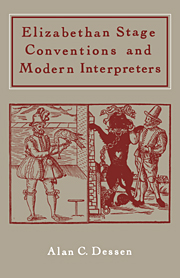Book contents
- Frontmatter
- Contents
- Preface
- Note on texts and old spelling
- 1 The arrow in Nessus: Elizabethan clues and modern detectives
- 2 Interpreting stage directions
- 3 The logic of ‘this’ on the open stage
- 4 Elizabethan darkness and modern lighting
- 5 The logic of ‘place’ and locale
- 6 The logic of stage violence
- 7 Theatrical metaphor: seeing and not-seeing
- 8 Conclusion: Elizabethan playscripts and modern interpreters
- Notes
- List of plays and editions
- Index
6 - The logic of stage violence
Published online by Cambridge University Press: 22 September 2009
- Frontmatter
- Contents
- Preface
- Note on texts and old spelling
- 1 The arrow in Nessus: Elizabethan clues and modern detectives
- 2 Interpreting stage directions
- 3 The logic of ‘this’ on the open stage
- 4 Elizabethan darkness and modern lighting
- 5 The logic of ‘place’ and locale
- 6 The logic of stage violence
- 7 Theatrical metaphor: seeing and not-seeing
- 8 Conclusion: Elizabethan playscripts and modern interpreters
- Notes
- List of plays and editions
- Index
Summary
As he raises up the axe strikes out his own brains
(The Atheist's Tragedy, v. ii. 241. s.d.)A third area where Elizabethan playscripts run afoul of modern expectations is to be found in the many moments of on-stage violence – duels, armed combats of many varieties, murders, even maimings. Although evidence about the original staging of such scenes often is very limited (e.g., ‘they fight’; ‘kills him’; ‘alarms and excursions’), scholars generally have agreed how duels, sieges, and battles would have been presented at the Globe or Fortune or Rose. For example, stage historians argue forcefully that the players would have presented one-to-one fights (Mercutio versus Tybalt, Edgar versus Edmund) as convincingly as possible ‘in order to make the fencing scenes in their plays realistic enough to satisfy a critical audience well versed in the use of swords.’ As to battle scenes, the platform stage and the size of the companies provided various constraints, but, despite the apologetic stance provided by the Chorus to Act iv of Henry V, dramatists and actors were not intimidated by the prospect of lapsing into the ‘brawl ridiculous.’ Thus, even though some unsympathetic voices sounded out against swords, bucklers, drums, and trumpets, stage battles appealed to audiences for several decades and remained an integral part of Shakespeare's plays from i Henry VI through Coriolanus and Cymbeline.
- Type
- Chapter
- Information
- Elizabethan Stage Conventions and Modern Interpreters , pp. 105 - 129Publisher: Cambridge University PressPrint publication year: 1984



